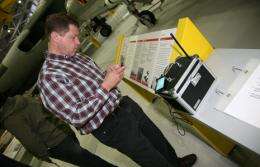Nokia uses 'white spaces' technology for indoor positioning (w/ Video)

Scott Probasco is roaming the floor of the hanger at the Imperial War Museum, Duxford, with a Nokia N9 attached to a small box. He passes Concorde, turns right at a World War One bi-plane and pauses underneath a sea rescue helicopter suspended from the ceiling.
Strategically placed signs give detailed information about the history of the historic planes on display at the former airbase outside Cambridge, but Probasco, a Senior Manager at Nokia, doesn’t need to look at them. Using the N9 he is demonstrating a three year Nokia research project to develop indoor information delivery using TV white spaces.
TV white spaces are unused parts of the TV spectrum at a particular location. So, for example, part of the signal reserved for a London TV channel may not work in Cambridge – resulting in a ‘white space’ which can potentially be used for proving better and cheaper internet access.
Nokia is demonstrating how indoor information delivery might use this as part of the Cambridge TV White Spaces Trial, which has brought together a consortium of 17 leading technology and media companies.
“We are interested in TV white spaces from the perspective of getting more radio spectrum to give greater internet access capacity,” Probasco explains.
“It’s a new and novel way to access the spectrum. The existing ways are inefficient. Because white spaces are unlicensed we can deploy systems and provide internet access more cheaply.”
White spaces can be used to launch new services, like the Nokia demo at the Imperial War Museum:
“You know when you go to a museum and you put the headset on, and listen to the information about what you’re seeing,” Probasco says, “Well, this basically does away with that.”
As he roams the floor of the hangar the N9 detects his location and pushes him “offers” of information about the different planes.
The Imperial War Museum has vast archives, and multi-media content, which could never be dsiplayed on old-fashioned signs and maps. An indoor information delivery system, which museums could potentially develop as an app, “would be great for displaying that content,” says Ian Crawford, the museum’s head of ICT.
The demo also raises the possibility of developing the system for commercial use in locations like grocery stores, or shopping malls.
“Shop owners might install their own access point to give people free wifi,” says Probasco. “If they do that using white spaces, the users can be located and, as people walk by, the store can target them with offers and coupons. If this is a coupled with a loyalty program, then it can become even more tailored and targeted to what people want.”
The system has some unique advantages: “GPS works really well outdoors, but less well indoors. What we are doing here is about indoor positioning,” Probasco explains.
Unlike information that comes from crowd sourcing, or ‘war driving’, the system uses information automatically generated from a government mandated database that is activated when the equipment in turned on.
It’s hard not to notice the box Scott is carrying around, attached by a cable to the N9. The box is a simple radio system operating in UHF TV bands that connects to a TV white space database to determine which TV channels are available for use.
The Nokia N9 connects to the Internet over the TV white space, and the App contacts the Nokia service on the Internet. Using the location provided by the TV white space database, the Nokia servers then deliver information about nearby aircraft to the App in the phone.
The phone uses signal strength measurements to refine the location provided by the TV white space database, which is accurate to about 10 metres.
“Before this system can be used in commercial devices, and we can get rid of this box, we need mass produced chips to fit inside the phones, and those will only come when the standards have been developed,” Probasco says. That technology will probably not be standardized and available before 2015. Before then Nokia is investigating other trials in Brazil, Singapore and Finland.
Scott Probasco and Ian Crawford resume walking the hanger, passing the aircraft that transformed the 20th Century, while discussing the kind of forward-thinking innovation in mobile technology that will transform the next.
Provided by Nokia



















